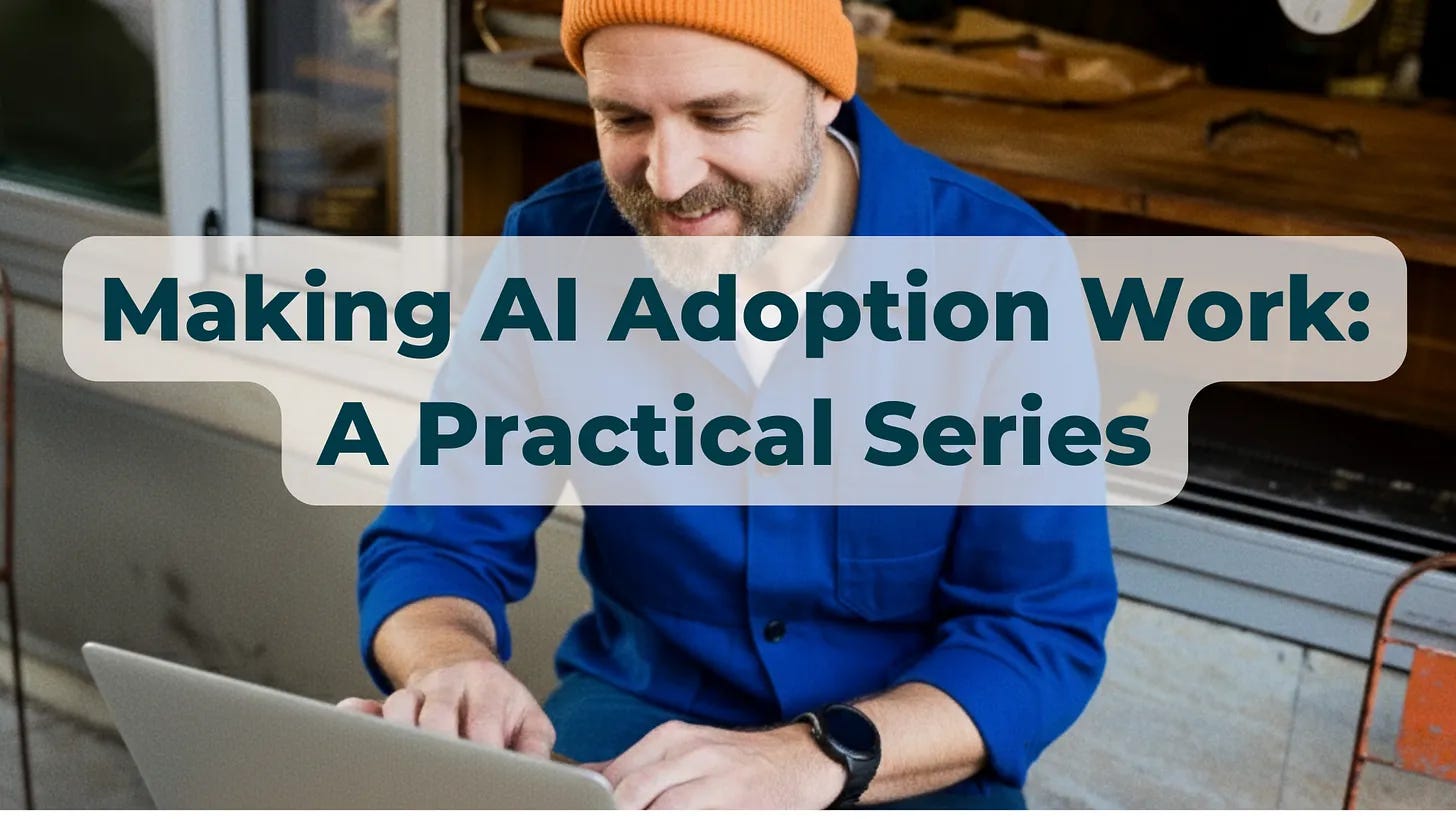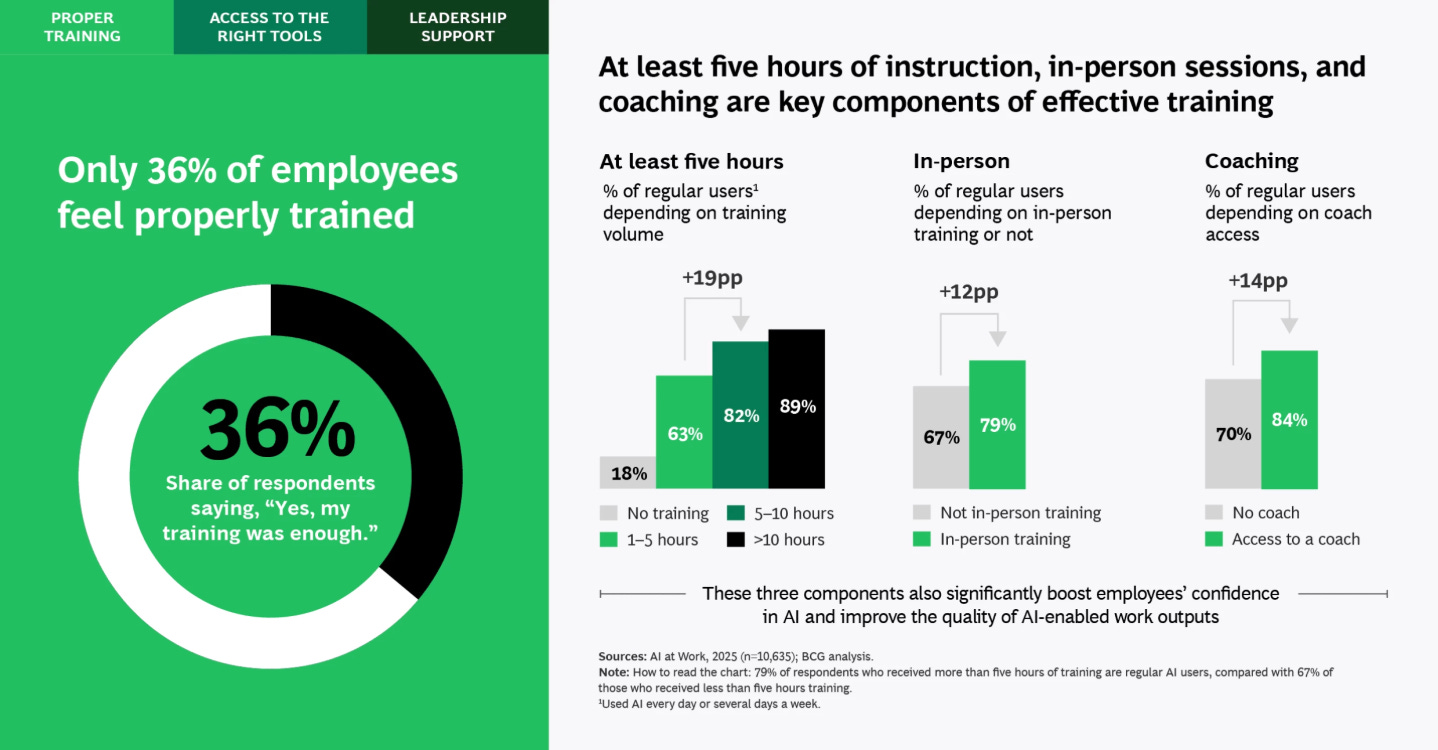The 5-Step System for Employee AI Training That Works
Stop Doing One-Hour AI Training
Welcome to FullStack HR, and an extra welcome to the 75 people who have signed up since last week. If you haven’t yet subscribed, join the 10000+ smart, curious leaders by subscribing here:
Happy Thursday!
Exciting news! (at least I think so 😃).
I’m teaming up with
If you’ve read this newsletter a while, you know that AI is transforming every function, and that HR is no exception. From hiring and onboarding to performance and retention, leaders who know how to use AI to scale people’s impact will define the next decade of HR.
That’s why we built the Lead with AI Boot Camp: HR Edition.
In just 4 weeks, you’ll learn to identify where AI drives real ROI in HR, design adoption workflows that stick, and build an HR-led AI roadmap your execs will back.
That’s what Lead with AI Boot Camp: HR Edition is about.
You’ll walk away with:
✅ A live AI pilot connected to a real HR use case
✅ An adoption playbook with comms, training, and measurement tools (!)
✅ A 90-day rollout plan ready to launch
As with everything that I do, this is hands-on, clear, and built for HR leaders who want to make things happen, not just talk about them.
Only 25 seats at 50% off = $449 (!) for all of the above!
Cohort starts January 8, 2026. 👉 Reserve Your Seat Now
Or join the Info Webinar to see how it works 👉 Sign Up Here
That said, let’s get to it.
Most employees feel MORE positive about AI than their skill level.
I’ve spent this entire fall asking well over 6000 people two questions: How do you feel about AI, and how capable do you deem yourself to be using GenAI?
The gap between the two is bigger than the distance between my socks and matching pairs after laundry day.
But that’s also good news because it means willingness exists! It means there’s an opportunity for us to close that gap, because if we don’t close the gap, it will result in wasted license fees on tools that nobody uses.
Productivity gains that never materialize. And employees who are falling behind while competitors’ teams compound their advantages month after month.
Why One-Hour Workshops Are Useless
Most organizations offer a one-hour introduction to Copilot or ChatGPT, at best. A clear majority hasn’t offered their employees any training at all.
Depending on which study you read, you might see a number that is usually between 60-70%.
And there’s the one-hour inspirational session. You show some examples. Send people on their way. Then wonder why adoption is at 10% six months later.
The fundamental flaw? We’re treating this like software training when it’s a behavior change. I’ve seen this pattern too many times. Big kickoff. Everyone trained. Initial enthusiasm. Then nothing sticks.
What have I learned from doing this repeatedly for almost three years? Behavior change requires continuous reinforcement over time, connection to work, and peer learning. Not one-time events. Doesn’t matter how good your one session is.
Step 1: Start With Why (And Be Honest About It)
This is the foundation. Skip it, and people create their own narratives. Some decide it’s “I want to work less.” Others think, “I need to justify my existence.”
Everyone fills in their own story if you don’t give them one.
Here’s what you do: Articulate a clear why before any training starts. And I mean honest, not corporate bullshit honest.
If the why is “we’re not replacing people, but we’re not hiring more either” - say that. If it’s “we need to stay competitive and this is how” - say that.
When it’s done right, every employee can tell you back the why in their own words. Not your exact words, but they’ve connected it to something that matters to them.
I worked with one organization that said, “We’re making work better for the people who are here.” Clear. Honest. Employees connected to it. Another gave generic crap about “staying competitive” - nobody connected, training flopped completely.
This is preferably done by the lead team in your organisation (see part 1).
Step 2: Make It About Their Work (Not Your Examples)
This is where most trainers get it wrong. They show a bunch of clever examples. “Here’s how you prompt for X. Here’s how you do Y.” In my view, that’s secondary.
Ask these three questions before showing any technique or tool:
What do YOU do in your job daily?
What takes time or frustrates you?
What’s repetitive that you wish you could speed up?
My experience is that generic examples about “write better emails” don’t stick. But when someone uses AI to solve THEIR specific annoying task? Then employees can start relating to AI in a different way. They start asking “how did you phrase that question?” THEN you can teach prompting technique.
But it comes from their need, not your curriculum.
Start with their pain. Then show them the tools and let them solve their problems. Not the other way around.
This needs time. Minimum three sessions of 2 hours each. (Yes, that’s what it usually takes.) 6 hours total, spread out with space between sessions.
Why does the spacing matter? People need to try things in their real work between sessions. See and feel what works. See and feel what fails.
Come back with actual questions, not theoretical ones. Because the most common thing that fails? Finding time to make space for the AI part in their day to day. That’s a real barrier (and we adress it shortly). But if you do trainings with space in between, then you can also help to adress in session. If you do a one-trick pony and leave it there? Well, then that’s it. Impossible to follow up why people failed to use it on a day-to-day basis.
Without that try-fail-return cycle, you’re just doing awareness training. With it, you’re building actual capability.
Step 3: Build Continuous Learning Into How You Already Work
Different organizations require different approaches, tailored to what already works within their culture.
If you’re meeting-heavy: Take away one weekly meeting. Dedicate that hour to AI work. If you’re async-first, build five minutes into standups to share what someone tried. If you’re deadline-driven with no slack, start by just showing how AI saves time on tasks people already hate.
The common thread that makes any of this work: Manager support from part 3. If managers aren’t reinforcing this, it dies. That’s not theory, that’s what happens every single time I see this fail.
And as mentioned before, I’ve changed my mind on this over time. I used to think that employee training could be done without manager buy-in. You can’t. The manager layer is make-or-break.
Step 4: Add Peer Learning For the Last Push
Once you’ve got the foundations from Parts 1-3 in place and formal training done, you can push adoption higher with peer learning.
Monthly lunch-and-learns where employees show real examples from their work. Slack channels for sharing prompts and questions. Pairing people as AI buddies who check in weekly. These aren’t replacements for proper training - they’re the layer that helps it stick.
What makes this work is it’s peer-to-peer, not top-down. People see what their colleagues are doing with AI in real work situations. That creates both social proof and practical examples that formal training can’t provide.
It’s not uncommon that this sparks ideas and use cases either! Someone in accounting automates something. Someone in customer success builds a prompt library. You can’t predict these - but you can create the conditions for people to discover and share them.
This only works if you’ve done the groundwork. If leadership isn’t bought in, if managers aren’t trained, if the formal training was rushed - adding peer learning won’t fix those problems. This is for getting from 70% to 90%, not from 10% to 30%.
Step 5: Remember Why This Matters Beyond Productivity
My strong belief is that, done right, the productivity gains from AI are real. But there are other reasons you need to take this seriously that almost nobody talks about.
First, your employees’ individual competitiveness. People with AI skills have better career options now (and eve n That’s just reality. If you’re not training them, you’re making them less employable. Good luck with retention when they figure that out.
Second, your employer brand. Studies show workplaces without AI enablement are becoming less attractive, especially to younger talent. You’re competing for good people against companies that ARE investing in this. You think that doesn’t matter?
Third - legal protection. Especially in Europe. Let’s say you end up needing to make tough calls about headcount. You’ve got some employees who embraced AI and are highly productive. Others who didn’t. Who would you like to keep if you had to make the choice? My guess is the former.
But European labor law doesn’t let you just say “we’re keeping the AI-native ones.” The union will immediately ask: “What training did you provide?” If your answer is “uh, a one-hour thing twelve months ago” - you don’t have legal standing. You can’t use adoption as criteria if you didn’t give people real opportunity to adopt.
And fourth, compliance with the EU AI Act. AI literacy is legally required as of February 2, 2025 for organizations using AI systems. No direct sanctions on the literacy requirement itself, but indirect ones. If something goes wrong with an AI system, and regulators look at your training records? “One-hour awareness session” isn’t going to cut it.
So ask yourself, if regulators or unions asked tomorrow what training you’ve provided, what would you show them? If the answer makes you uncomfortable, you know what you need to fix.
When You Want the Easy Way Out
Many organisations want to “get this over with.” They simply want to train everyone quickly, using one-hour sessions. I get it. Scheduling is hell. Ongoing programs cost money. One-and-done feels efficient.
To some extent, it is, at least on the surface. “Click here, do this, done.”
But will it stick? Not likely.
AI adoption is a behavior change. Behavior change needs repetition, reinforcement, peer proof, and manager support. All the “annoying” stuff that takes time.
But what if you’ve done the “one-hour-session”-implementation plan and now feel that you want to do something else? Don’t despair. But add continuous elements now.
Reframe it, low adoption after training isn’t failure. It’s a signal you’re missing the continuous layer. That’s fixable.
Start with honest why. Map training to actual individual work, not generic examples. Build continuous learning into existing rhythms. Create peer spaces for exchange. Document everything for legal protection. Add a more extended training session. Monthly sharing. Peer buddies. Manager check-ins. You’re not starting over, you’re adding the missing pieces.
And each piece builds on the previous.
No clear why? People don’t engage.
No connection to their work? Stays abstract.
No continuous reinforcement? Enthusiasm fades in weeks.
No peer learning? Adoption stays siloed.
If you’ve only done one-time training, add ONE continuous element this month. Monthly sharing session. Slack channel. Buddy system. Something that creates ongoing contact. That one change will have a greater impact than another one-time training session.
Hit reply if you’re stuck on any of this!






